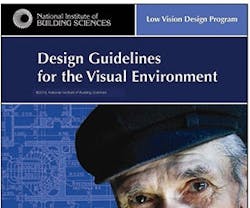Who is packing a wallop to improve healthcare design? There are many organizations—non-profits, trade associations, and standards-writing entities—that have been working on updates that will improve healthcare design solutions. The goal is to impact health and wellness for residents, patients, staff, and families, influencing design decisions for improved outcomes.
Aging Eyes and Lighting
One exciting development that has been under way for several years is the long-awaited update to the Illuminating Engineers Society (IES) Standard: ANSI/IES RP-28 Lighting and the Visual Environment for Senior Living. With so many changes happening in lighting technology, this updated standard is anticipated to be completed for publication soon. The updated table that includes foot-candle recommendations for designers to utilize will also be referenced in the proposed 2018 “Guidelines for Design and Construction of Residential Health, Care, and Support Facilities,” published by the Facility Guidelines Institute. Often, healthcare designers do not realize that utilizing and referencing these requirements will not only improve long-term care settings, but other healthcare spaces as well.
Acoustics and Outcomes
Because hospital acoustic guidelines are not necessarily applicable to long-term care settings, a task force has been established by The Mayer-Rothschild Foundation in cooperation with the Facility Guidelines Institute to evaluate specific recommendations for these spaces. This task force is led by David Sykes of Remington Partners, Inc. and Kurt Rockstroh of Steffian Bradley Architects. Mandy Kachur from Soundscape Engineering, LLC has participated in the research and acts as the liaison between the work of the task force and the Health Guidelines Revision Committee (HGRC) of the Facility Guidelines Institute. The proposals for “Guidelines” submitted by Kachur were based upon initial findings of their research at Brooksby Village, an Erickson Retirement Community located outside of Boston. The groundbreaking work that is being completed will impact not only the 2018 cycle of the Residential Guidelines, but also the 2022 cycle.
Sustainable product Certifications
For sustainable materials, the United States Green Building Council (USGBC) is actively looking at alternative compliance paths for both pilot and standing credits within LEED v4. This is exciting news, as it demonstrates that all of the work completed by manufacturers on the NSF Sustainability Assessment Standards for certification of interior products and materials are being considered as part of the compliance to LEED v4 credits. As examples, this would include NSF/ANSI Sustainability Assessments for resilient flooring (NSF/ANSI 332), carpet (NSF/ANSI 140), and wallcovering (NSF/ANSI 342). The proactive trade associations involved in the development of these sustainable certifications include the Resilient Floor Covering Institute (RFCI), the Carpet and Rug Institute (CRI), and the Wallcoverings Association (WA)—all leaders in working toward sustainable solutions. Green Globes for New Construction (NC) includes credits that address multiple-attribute certifications, as well as addressing material and resources from a life cycle perspective in the GBI ANSI revision process currently underway.
Caregivers
The opportunities for change come through collaboration—identifying gaps that have not been filled and crossing over boundaries to share commonalities. Locating where the needs exist and expanding to encompass the changes that are required are the most difficult in healthcare settings. The best source of information from a programming perspective are the caregivers and hands-on service providers. Frontline staff are the people who participate with residents and patients on a regular basis, and provide insights that C-Suite and administration do not observe.
PageBreakIn 20 years of completing focus-group work, I find the most valuable information comes from the front line staff and the patients or residents. There is a realistic view of the challenges that they face every day. They know that each resident or patient is not the same, each one unique with different needs, likes, and dislikes. In long-term care, consistency of staff with residents has demonstrated positive outcomes. When staff go above and beyond their job descriptions blurring the line of responsibility, to go out of their way to help someone—these are the champions of healthcare. Listening and learning from them can positively impact and change a care system for the better.
Jane Rohde is the founding principal of JSR Associates, Inc., located in Ellicott City, Md. She champions a global cultural shift toward de-institutionalizing senior living and healthcare facilities through person-centered principles, research and advocacy, and design of the built environment. Clientele includes non-profit and for-profit developers, government agencies, senior living and healthcare providers, and design firms. Rohde speaks internationally on senior living, aging, healthcare, evidence-based design, and sustainability. For more information or comments, please contact Rohde at [email protected].
Student Profile
In her ongoing work in healthcare design, Jane Rohde is keeping an eye on students whose work and studies are making an impact in the field. Read on to learn more about this month’s featured student designer.
Project Description
Maher is working on a research project called, “The Effect of LED Lamp Color Temperature and Luminance on the Written Task Performance of older Adults.” With all of the fast-paced changes in lighting technology, her research is an important part of understanding if LED lamps can positively affect the visual acuity of older adults, supporting as much independence as possible. The goal of her work is to determine the color temperature and illuminance level of LED lamps that will be best suited for completion of written tasks. No matter what setting an elder is living in, appropriate light levels are directly tied to quality of life.
Maher has devised a portable light box similar to that used by O’Conner and Davis (2005) in their study and started testing with elders in October 2016. Measurements were taken with the CL-500A Illuminance Spectrophotometer. LED lighting as an enhancement to natural lighting in senior living settings is hoped to be not only decorative, but to also increase functionality. Tunable LEDs allow for control of light quality, color, and quantity. Maher’s research project is focused on how LED lamps affect the aging eye, as well as color temperature in relationship to effectiveness of LED lighting solutions for elders.
About the Author

Jane Rohde
AIA, FIIDA, ASID, ACHA, CHID, LEED AP BD+C, GGA-EB
Jane Rohde, AIA, FIIDA, ASID, ACHA, CHID LEED AP BD+C & GGA – EB: Jane Rohde is the founding principal of JSR Associates Inc. in Catonsville, MD. JSR Associates Inc. celebrates 23 years of consulting services in 2019. Jane is the recipient of the 2015 Environments for Aging Changemaker Award and in 2018 she received the ASID Design for Humanity Award, was recognized as an Honorary Alumni of Clemson University’s Architecture + Health program, and has been honored as one of 10 notable Women in Design. For more information or comments, please contact Jane Rohde at [email protected] or “Chat with Jane” at www.jsrassociates.net.
